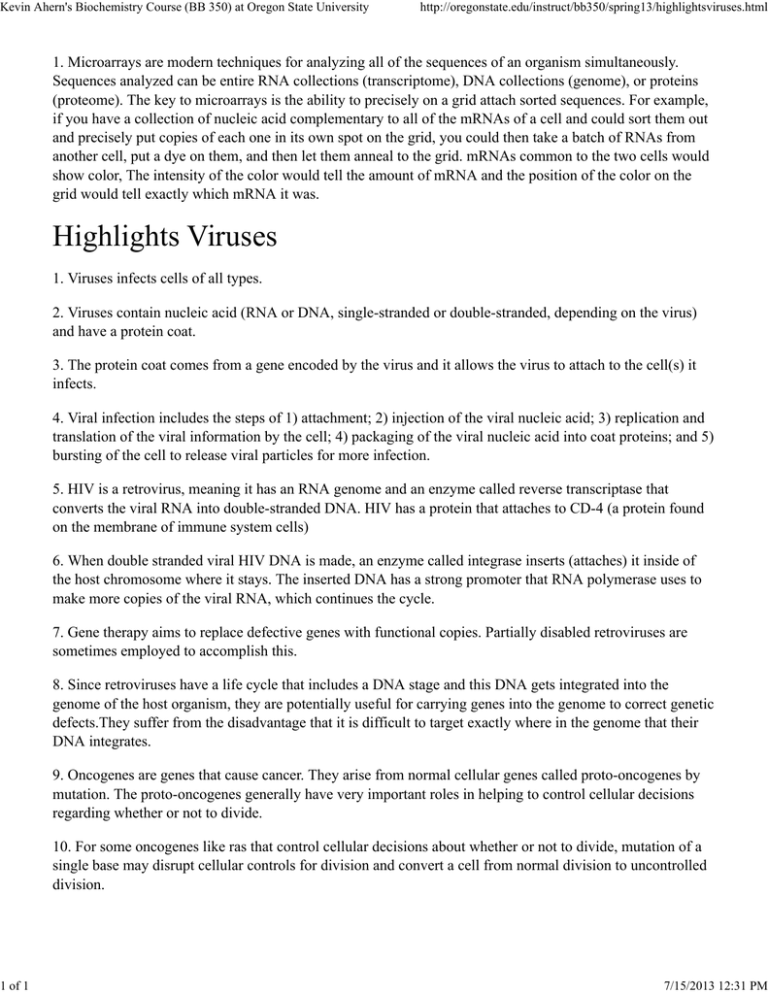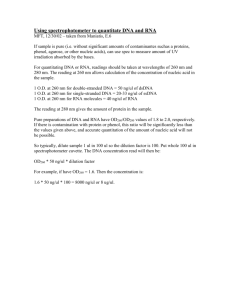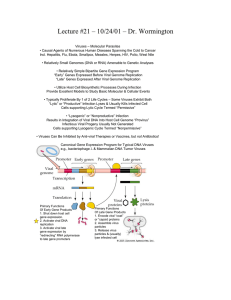Kevin Ahern's Biochemistry Course (BB 350) at Oregon State University
advertisement

Kevin Ahern's Biochemistry Course (BB 350) at Oregon State University 1 of 1 http://oregonstate.edu/instruct/bb350/spring13/highlightsviruses.html 1. Microarrays are modern techniques for analyzing all of the sequences of an organism simultaneously. Sequences analyzed can be entire RNA collections (transcriptome), DNA collections (genome), or proteins (proteome). The key to microarrays is the ability to precisely on a grid attach sorted sequences. For example, if you have a collection of nucleic acid complementary to all of the mRNAs of a cell and could sort them out and precisely put copies of each one in its own spot on the grid, you could then take a batch of RNAs from another cell, put a dye on them, and then let them anneal to the grid. mRNAs common to the two cells would show color, The intensity of the color would tell the amount of mRNA and the position of the color on the grid would tell exactly which mRNA it was. Highlights Viruses 1. Viruses infects cells of all types. 2. Viruses contain nucleic acid (RNA or DNA, single-stranded or double-stranded, depending on the virus) and have a protein coat. 3. The protein coat comes from a gene encoded by the virus and it allows the virus to attach to the cell(s) it infects. 4. Viral infection includes the steps of 1) attachment; 2) injection of the viral nucleic acid; 3) replication and translation of the viral information by the cell; 4) packaging of the viral nucleic acid into coat proteins; and 5) bursting of the cell to release viral particles for more infection. 5. HIV is a retrovirus, meaning it has an RNA genome and an enzyme called reverse transcriptase that converts the viral RNA into double-stranded DNA. HIV has a protein that attaches to CD-4 (a protein found on the membrane of immune system cells) 6. When double stranded viral HIV DNA is made, an enzyme called integrase inserts (attaches) it inside of the host chromosome where it stays. The inserted DNA has a strong promoter that RNA polymerase uses to make more copies of the viral RNA, which continues the cycle. 7. Gene therapy aims to replace defective genes with functional copies. Partially disabled retroviruses are sometimes employed to accomplish this. 8. Since retroviruses have a life cycle that includes a DNA stage and this DNA gets integrated into the genome of the host organism, they are potentially useful for carrying genes into the genome to correct genetic defects.They suffer from the disadvantage that it is difficult to target exactly where in the genome that their DNA integrates. 9. Oncogenes are genes that cause cancer. They arise from normal cellular genes called proto-oncogenes by mutation. The proto-oncogenes generally have very important roles in helping to control cellular decisions regarding whether or not to divide. 10. For some oncogenes like ras that control cellular decisions about whether or not to divide, mutation of a single base may disrupt cellular controls for division and convert a cell from normal division to uncontrolled division. 7/15/2013 12:31 PM




